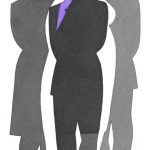Introduction
Antigua, Guatemala is more like an outdoor museum than a living city, overloaded with colonial Spanish architecture, yellow-ochre-blue walls, tiny specialty shops full of artwork, paintings and local jewelry, touristic but charming cafes serving quiche or dark chocolate drinks and dozens of old church ruins–and functioning ones as well–rough cobblestone roads constantly under repair, high-end and low-end hotels. Woven into the charm is a small gay community of friends.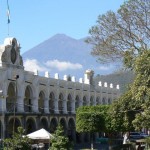
By Richard Ammon
GlobalGayz.com
February 2012
A Modest Gay Scene
This former capital city is clearly a destination place for locals and foreigners, for craftsmen, laborers, big spending visitors and Mayan vendors. At the core is Central Park with its dribbling mermaid fountain surrounded by palatial arcaded buildings, a downsized wedding-cake cathedral and horse-drawn carriage taxis. The whole place looks like a movie set for an Ivory-Merchant film of genteel by-gone Latin American life.
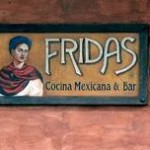 Thousands of tourists come and go each year and many fall in love with the city and stay to earn a livelihood. Among the stay-at-home folks are a small LGBT community of friends and acquaintances who all know each other but are not organized into an association, mostly business people. There is little need for gay rights activism here as there is in nearby Guatemala City. (See other story: Guatemala City has gay numerous saunas and bars as well as an LGBT activist organization called Oasis.)
Thousands of tourists come and go each year and many fall in love with the city and stay to earn a livelihood. Among the stay-at-home folks are a small LGBT community of friends and acquaintances who all know each other but are not organized into an association, mostly business people. There is little need for gay rights activism here as there is in nearby Guatemala City. (See other story: Guatemala City has gay numerous saunas and bars as well as an LGBT activist organization called Oasis.)
There is virtually no LGBT discrimination here in hotels, markets, restaurants or public venues. The place could be called ‘gay light’ since there is no active ‘scene’. Instead, woven into the fabric of Antigua life are several LGBT gay-owned restaurants/bars/cafes where there are occasional LGBT nights, one in (lesbian owned) Frida’s bar/restaurant (last Saturday of each month) and certain nights at Ricky’s bar a block away. Casbah disco is known as gay friendly all the time. There are two gay-owned restaurants, daVinci and Ubis both in central area.
And that’s it for the public LGBT scene–unless strolling/cruising at sunset in Central Park is included. Here are some of the LGBT folks who are happily living and working in Antigua.
Jack and Bismarck: American and Nicaraguan
The network is small which makes meeting the local gays easy. I was pointed to the small informal cafe-eatery called Gringo-Chapin located behind the cathedral.
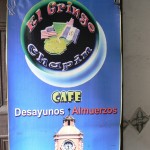 Sitting in Jack and Bismarck’s Restaurant, one would hardly guess the owners are a long term gay couple enjoying la dolce vita–or la vita lavorativa–as they serve up tasty breakfast and lunch seven days a week, Jack as waiter and Bismarck as cook. Jack in his fifties and Bismarck in his late thirties operate smoothly together and the result is a satisfying business of good food and conviviality for locals and visitors. The serve a fixed-menu each day with a fixed-price–one of the best bargains in town.
Sitting in Jack and Bismarck’s Restaurant, one would hardly guess the owners are a long term gay couple enjoying la dolce vita–or la vita lavorativa–as they serve up tasty breakfast and lunch seven days a week, Jack as waiter and Bismarck as cook. Jack in his fifties and Bismarck in his late thirties operate smoothly together and the result is a satisfying business of good food and conviviality for locals and visitors. The serve a fixed-menu each day with a fixed-price–one of the best bargains in town.
The men met seven years ago online, in Guatemala, and it was “pretty much love at first sight”, said Jack, who is originally from Michigan. After twenty years of straight marriage and three children, now all grown with their own children. Jack was anonymously outed to his wife which aborted their marriage and after a period of shock and trauma in the family he moved out and subsequently pursued an authentic gay life. Two years later when he and Bismarck, originally from Nicaragua, came into each others’ lives they felt a sense of completion that had eluded them for a long time. (photo: Jack and Bismarck)
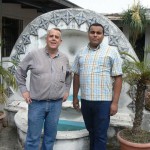 When asked if there were any cultural differences between their being an American and a Honduran that created problems for them, they paused to think and could not name any. “But,” Jack explained, “keep in mind I had already lived in Guatemala for 15 years during my marriage so I was very acculturated to Guatemala and Latino culture by the time I met Bismarck. I understood and respected their social and culture norms, and Nicaragua is not so very different from Guatemala, so we did not have bi-cultural issues that one might find, say, between a Western guy and an Asian.”
When asked if there were any cultural differences between their being an American and a Honduran that created problems for them, they paused to think and could not name any. “But,” Jack explained, “keep in mind I had already lived in Guatemala for 15 years during my marriage so I was very acculturated to Guatemala and Latino culture by the time I met Bismarck. I understood and respected their social and culture norms, and Nicaragua is not so very different from Guatemala, so we did not have bi-cultural issues that one might find, say, between a Western guy and an Asian.”
Bismarck added that any friction they had was due to personality differences. “I’m a control freak so we had to talk about that.” Jack chuckled in agreement but didn’t feel that was much of a problem.
Religion is not a divisive issue for them since neither of them follow any denomination closely. Bismarck was raised as a Catholic “but not like a fanatic.” Jack’s roots were Presbyterian but migrated into evangelical worship in his early twenties. His original trip to Guatemala was as a missionary for his church and as a participant in Living Water Teaching, a fundamentalist charitable organization offering medical and educational services in Guatemala (like numerous other faith-based organizations here).
Money was also not an issue. A common differential between an American Anglo and a Nicaraguan is often money and therefore power. But Jack did not come into the relationship with wealth, after his marriage breakup, and easily accepted Bismarck as an equal partner. There was no imbalance in decision-making, priorities or leadership so today they have built a respectful equitable and loving partnership and enjoy working in their restaurant and living nearby.
Gonzalo the Authentic Mayan
A few blocks away, working in the huge native arts and crafts market, Nim Pot, Gonzalo Ticun (photo below) is a Mayan Guatemalan who has lived here all his life. An open and gregarious man in his forties he can be seen dressed in native clothes of bright colors and a straw bowler hat. We lunched at Ricky’s bar/cafe one afternoon as he responded to my questions about Mayan attitudes toward homosexual natives. “Historically, the Mayan shaman was often ‘gay’ but they didn’t call it that. He was considered a wise person of sexual ambiguity who interacted with his community emotionally and physically, as the occasion demanded.”
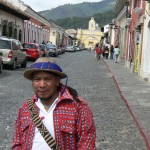 If a couple were having a marriage problem they might consult with the shaman to sort out the issues. If a man were confused or insecure sexually the shaman might teach him and provide him with knowledge or have a sexual experience with him. “It was not a shameful thing to do then.
If a couple were having a marriage problem they might consult with the shaman to sort out the issues. If a man were confused or insecure sexually the shaman might teach him and provide him with knowledge or have a sexual experience with him. “It was not a shameful thing to do then.
But this tradition has been sullied by religion, especially by the protestant churches who have usurped the shaman’s role with fundamentalist Christian ideas about everything from marriage to morals and sexuality. Same-sex activity is grouped together as an evil along with prostitution, drug and alcohol usage and immorality. Sex is a shameful thing to these church people and especially any same-sex activity.” It has been a sad loss to replace the shaman’s gentle sexual learning with shame-based puritanical sin.
(Meanwhile in the much bigger city of Guatemala City–about 3 million people–Gonzalo has noticed that younger gays are more bold and expressive and less afraid to be out. There are now four or five saunas and about ten gay bars across the city.)
Gonzalo is now 45 and did not come out to his family until he was in his twenties. His macho father was quite angry, which was nothing new as the two had not been close. Since he was a late teen his father had pressured Gonzalo to marry and have a family. “He was very much stuck in that machismo thinking and did not know anything else was possible. He was very angry that I resisted.”
In his late twenties Gonzalo considered going into a monastery but was advised not to after he admitted his truth to a clergyman, “because there are all men there and sex was not allowed.”
His mother was more understanding and was concerned for his health and safety. She advised him to be careful and be discrete.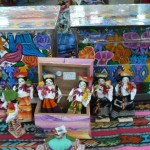
He now lives in a nearby village near Antigua, Sacatepeguez, in his own house that is near to other family members. He has had a couple of lovers but they were foreigners who did not live full time in Guatemala. Like many LGBT people he uses the internet to chat and cruise but is not seriously looking for a partner. “It will happen if it’s going to happen.”
He wants to start a volunteer teaching program in his village in which English-speaking visitors come to stay for a week or more and give English lessons to young students; Gonzalo would provide housing in exchange for their efforts and the guests would only pay for food. Of course he would prefer if the guests were LGBT community members but he would not turn away anyone with charitable intentions.
Dahr and George–Ladino and American
Another set of gay persons (not a couple) of note in Antigua are George Sansoucy and his business associate Dahr Mora. Their business is tourism aimed at LGBT tourists from abroad, although not exclusively. It’s called George’s Travel Club. The Club is small but growing comfortably with local tours that range from one day to six days.
“I came here for love–and stayed even though that changed, after 7 years. I am forever grateful for his having introduced me to Antigua. Gay life here is indeed woven into everyday life and has its appropriate place as part of Antigua life, but not the center of Antigua life,” described George. “My own gay lifestyle feels even more ‘integrated’ here than it did in NYC, and I love that my life here now has equal time with gay, non-gay people, both Guatemalans and foreigners. It’s stimulating to be surrounded by people pursuing their passions here, whether it be art or community service or giving tours or making chocolate. It appears to me that most everyone seems to be doing/pursuing something fun and interesting. This is great and inspiring energy to be around.”
(In addition to George’s words, it is obvious that Antigua is populated mostly with native citizens who also work in the city but are less entrepreneurial. Most of these workers are in the service and domestic and laboring sector, such as road repairmen, bus drivers, policemen/women, hotel housekeepers, painters, restorers taxi drivers, city employees and other vital professions that keep the city beautiful and appealing.)
George (photo right) is irrepressibly pro-Guatemalan and pro-bu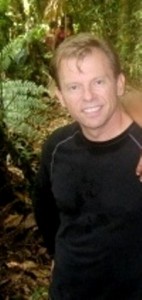 siness when he talks. “With 33 volcanoes, 21 separate languages, 19 different ecosystems & countless Mayan and Colonial ruins, it’s no surprise that Guatemala is also mentioned four times in the #1 Bestseller, 1,000 Places to See Before You Die. Antigua, Guatemala’s most beautiful and historic city, is like having a little bit of Europe, just south of the border, but at a fraction of the cost. Nearby is Lake Atitlan and not far away are the Mayan Ruins of Tikal; both are world treasures. With daily flights from many major US airports, Guatemala is easy to get to and in less time than it takes to fly to Europe or Hawaii.
siness when he talks. “With 33 volcanoes, 21 separate languages, 19 different ecosystems & countless Mayan and Colonial ruins, it’s no surprise that Guatemala is also mentioned four times in the #1 Bestseller, 1,000 Places to See Before You Die. Antigua, Guatemala’s most beautiful and historic city, is like having a little bit of Europe, just south of the border, but at a fraction of the cost. Nearby is Lake Atitlan and not far away are the Mayan Ruins of Tikal; both are world treasures. With daily flights from many major US airports, Guatemala is easy to get to and in less time than it takes to fly to Europe or Hawaii.
“Also, with two oceans bordering Guatemala, visitors can easily go to the Pacific for some world-class fishing or surfing, and on the Caribbean side one can sail around the beautiful coastal islands and coral reefs of Belize.”
And just to be sure, he added, “custom-made gay travel services for Guatemala can be found by visiting George’s Travel Club of Guatemala at www.georges-travelclub.com (202-436-9983).”
I lunched with Dahr one afternoon at picturesque Sabe Rico (‘Good Taste’) restaurant in central Antigua (they also sell their own chocolates) and he easily talked about the business and his own personal journey to mature gay selfhood. Like many young Guatemalans in the 70s and 80s he lived for a time outside the country because of the chaotic civil war that raged here from 1960-1996. Many families took their children out of harm’s way to America or Europe. Dahr grew up raised mostly by his grandparents learning several languages. When the war finally wore itself out with no clear winner, he was able to safely return and finish his schooling.
By the time he came out to himself he was 22. Previously he had not realized his true sexual orientation other than a vague notion that he liked men, even while he dated a girlfriend for a year. Then suddenly he met Rene and “something magical happened’ as the two fell intensely in love–for six months. It was Dahr’s abrupt introduction to the agony and ecstasy of love and homo-desire. But eventually they discovered they had different interests and styles and managed to part as friends.
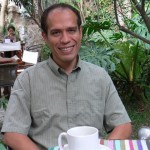 Dahr (photo left) is of mixed ethnic descent (Ladino–not Latino) with no Mayan heritage. His grandparents had died by this time and his mother lived in Mexico so he had no serious family problems to contend with at home. He was fortunate not to be trapped in a strong heterosexual family tradition that forced him to live a double life. He is free to choose his life as a professional businessman and his personal lifestyle.
Dahr (photo left) is of mixed ethnic descent (Ladino–not Latino) with no Mayan heritage. His grandparents had died by this time and his mother lived in Mexico so he had no serious family problems to contend with at home. He was fortunate not to be trapped in a strong heterosexual family tradition that forced him to live a double life. He is free to choose his life as a professional businessman and his personal lifestyle.
Subsequently he formed another relationship, with Alex, that lasted four years during which he learned the complexities of intimacy and felt the emotional roller-coaster of finding compatibility. When he took a job in Monterrico city on the Pacific coast and was gone for days at a time, his partner became insecure and suspicious and accused Dahr of cheating. Dahr was dumbfounded. This grew into an explosive issue that eventually broke up the relationship. It was very confusing and hurtful for Dahr since he had never experienced such unstable emotion in a partner. It was a painful breakup but in the past three years since, they have become better friends.
Still feeling uncertain about love he is reluctant to form another relationship but he is open the possibility with the ‘right’ person–or at least more right than Alex.
Mayan Life
Another unique aspect of gay Guatemalan life, Dahr said, had to do with the matriarchal society that exists ‘behind closed door’s in families. Despite the outward macho bravura of male dominance in public it is 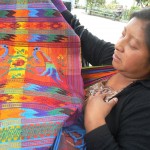 the woman who is really charge of the family. She is the strong figure who gives birth and protects the home and raises the children.
the woman who is really charge of the family. She is the strong figure who gives birth and protects the home and raises the children.
The man’s role is more like a ‘work horse’, said Dahr, to find work and provide money and do the rough work. The matriarchal role is a strong influence that is imposed on and expected from young girls to carry into their own eventual heterosexual families. If a girl declares her lesbian desires she is essentially rejecting the highly valued matriarchal mother tradition of her lineage which almost always evokes anger and disruption in the family, especially from the mother.
Dahr said that mothers have less difficulty with a gay son than a gay daughter because of this rejection of the dominant female role.
A Bit of Mayan History
Same-sex activity certainly existed a long time before modern LGBT life in Guatemala. During our talk, Dahr mentioned archeological discoveries of ancient Mayan ‘gay’ cave drawings that depict tribal life, including evidence of child sacrifice, ritual bloodletting, social and sexual intercourse and sacred activities.
Dahr recalled there were also depictions in the caves of two males apparently in a sexual act. A search of the internet found this website (http://connellodonovan.com/archaeo.html) where researcher and archeologist Connell O’Donovan presents Late Classic Mayan cave paintings and fragmentary hieroglyphs dating to the 700s from Naj Tunich caves, in Poptún southern Peten, Guatemala. 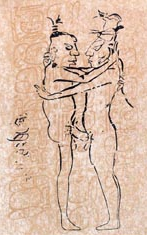 These are the most extensive Mayan cave archeology sites in the country. Some anthropologists believe the sacred activities and sacrifices may have been accompanied by altered states of consciousness induced by alcoholic or hallucinogenic substances.
These are the most extensive Mayan cave archeology sites in the country. Some anthropologists believe the sacred activities and sacrifices may have been accompanied by altered states of consciousness induced by alcoholic or hallucinogenic substances.
The caves’ discovery in the 1970’s opened up deeper understanding–and mystery–about Mayan culture than had previously been known. The extensive wall sketches depict many aspects of life included the homosexual one Dahr mentioned. It is of an older man and a younger man in an erotic exchange, an embrace yet standing a little apart, but clearly touching each other with their erections. (photo: fragmentary hieroplyph dating to the 700s ce) Dr. Karen Olsen Bruhns of San Francisco State University’s Anthropology Dept. has commented that this is “the only genuine depiction known of male-male erotic interaction” in the Americas. Adding to the mystery and meaning, the younger man (on the right) is adorned with what seems to be a Lunar Goddess hair lock down his back.
It is difficult to know what the meaning is; perhaps a fertility ritual, or intimate contact or a fantasy image. It could be supposed that since the younger man is wearing a feminine garment/headdress that he is acting (or seen) in a female demeanor or sexually ambivalent role that was part of a ritual now long forgotten. If we consider Gonzalo’s comments that Mayan shamans were of ambiguous sexual nature perhaps this cave drawing is an ancestor of that tradition, which would shift the ‘intercourse’ from carnal and sexual to emotional and spiritual, possibly offering the older man a rejuvenation of his potency or increase of fertility. (?)
DaVinci, Walter and Luis
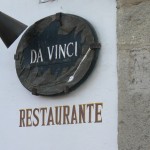 On the other side of the main square is the elegant and ornamented daVinci restaurant where Luis Estrada (photo below right) oversees the preparation and serving of a continental menu. It ranges from Italian to French to Greek. Luis and his partner Walter have been together for 13 years. Walter is an architect and event planner in Antigua.
On the other side of the main square is the elegant and ornamented daVinci restaurant where Luis Estrada (photo below right) oversees the preparation and serving of a continental menu. It ranges from Italian to French to Greek. Luis and his partner Walter have been together for 13 years. Walter is an architect and event planner in Antigua.
We were greeted and seated by Luis, a gregarious and cheerful man, He is unusually tall for a Guatemalan man, well over six feet and was happy to chat about of his two favorite topics, food and men.
Luis reaffirmed the low key gay community in Antigua, with no organization or central focus venue. “Every restaurant is gay-friendly here”—including the rowdy Reilly’s bar (easy to check out since the very noisy crowd spills out onto the street with rowdy gringo tourists and students).
At one point he observed the common cliché about macho men, that if they are in the top (power) position, it’s not gay sex. “I will fuck you but I won’t kiss you because I’m not gay,” he said, describing many ‘straight’ men.
I agreed since that was a general comment I’d heard throughout Central America. Then he added another twist to the cliché. “But not always. If you are in the bed and don’t do anything it’s not really gay sex; I mean if you are on the bed with your ass showing and it happens that you get screwed, it doesn’t mean you actually ‘did’ anything gay, you see? There are many ways a straight gay can fool himself!” Here was another convenient variation on the theme of denial to keep one’s macho self-image in tact.
In a follow-up e-mail, Luis said, “well look, Antigua is a very small town, but very touristic. That means it depends where are the people from, and Europeans are very open people, That’s why there are so many gays here. Normally guys from the big city came in the middle of the week because gay bars are not crowded, and here is fun. Tourists don’t care if it’s Monday or Saturday.

“One thing about here is that people are so friendly, and so many people travel alone. They have to be nice or they can’t speak, you know what I mean.” And the lasagna at DaVinci was divine!
Other Community Members
There are of course other LGBT singles and couples in and around Antigua as well as countless tourists–such as the pair of handsome young gay doctors from New York who targeted virtually every haute cuisine restaurant listed in the guidebooks. We met them on a walking tour one morning conducted by Elizabeth Bell, a long-time expat who gives a running historical and cultural and political narrative as she leads her groups around the centuries-old sacred and secular architectural gems of the town.
Other LGBT folks who live full time in Antigua include bi-cultural couples such as Gary and Carlos, Andre and Charles, Miguel and Arlo…and more.
In a thoughtful follow-up commentary, George offered further insight into the gay scene: “much of it is now online (ManHunt, Gaydar and GayRomeo seem to be the most popular with the Guatemalan Gay Community). Any middle-aged gringo that posts a profile with these sites in the Guatemala Sections is likely going to be very surprised at the many young gay men who are interested in meeting up. I think this is because gringos seem to be an ‘exotic’ attraction for many young Guatemalan gays. As well, some see gringos (or foreigners in general) as more stable and better resourced than gay Guatemalans.”
(This touches on the problems that indigenous gay people often have, that is, friction with family and straight peers who generally hold homophobic opinions arising out of long-conditioned religious influences. Another significant barrier to intimate self-expression is limited income; poverty for many does not allow for separate living quarters away from one’s family which limits privacy for a LGBT couple.)
“One thing is for sure”, George continued, “there is virtual no ‘ageism’ here. Younger dating older is not unusual at all, thus for many middle-aged gay gringos dating here can feel like a rebirth after feeling sidelined in the youth-oriented gay scenes of the U.S. This alone can be reason enough for many middle-aged gay men to move here. (BTW, this non-ageism does not appear to be Guatemala specific. I have had the same experience play out in Colombia, Peru and also Ecuador.)
We are everywhere.
Also see:
Antigua photo gallery
Famous Americans in Antigua
Rainbow LGBT Charity organization in Guatemala



